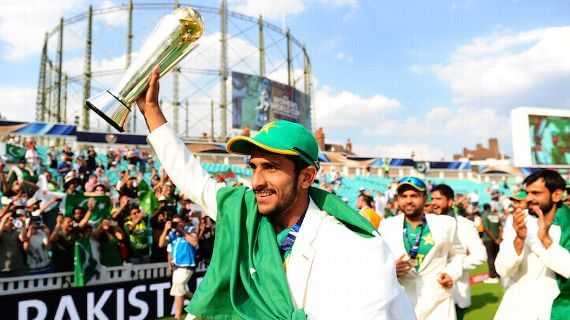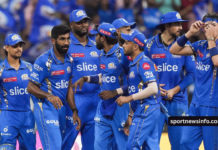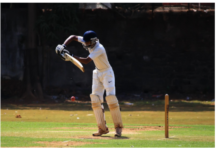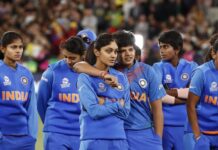The day after Pakistan won the Champions Trophy in 2017, ESPNcricinfo staff were asked to send in their recommendations for what they considered to be the team of the tournament, with the players receiving the most votes set to feature in a best tournament XI. A colleague sent out his list:
“1 Hasan Ali 2 Hasan Ali 3 Hasan Ali 4 Hasan Ali 5 Hasan Ali 6 Hasan Ali 7 Hasan Ali 8 Hasan Ali 9 Hasan Ali 10 Hasan Ali 11 Hasan Ali”
It barely struck anyone as an overreaction. Ali towered over everyone else – every other fast bowler, anyway – in that tournament, personifying the uncontained joy with which Pakistan began to approach each game, heading the crest of a wave taking them inexorably towards the title. He would finish with 13 wickets overall – no other bowler so much as cracked double-figures, or was as economical as his 4.29 runs per over.
He had made an excellent start to ODI cricket before the Champions Trophy anyway, and would soon go on to become the fastest Pakistani to 50 wickets in the format, eclipsing none other than current bowling coach Waqar Younis. He wasn’t all raw pace and mean, glaring eyes; he was skiddy and accurate. He had the wiles that made those skills all the more lethal, his slower one concealed behind a sleight of hand so deceptive Tony Slydini would be envious. Three months later, he would rise to become the number one ODI bowler in the world. At 22, it appeared Pakistan had unearthed another gem, a different one this time. And all the more precious for it. It was a meteoric rise as uplifting as it was unexpected.
Less than three years on from the fortnight in which he dismissed Faf du Plessis and JP Duminy, made fools out of Johnny Bairstow and Eoin Morgan and neutralised Ben Stokes and MS Dhoni, Hasan Ali has been cut adrift by Pakistan cricket. Central contracts the PCB handed out earlier this week revealed the No. 1 fast bowler in October 2017 was no longer among the best 18 players in Pakistan in 2020. A big culprit has been a troubling back injury in September 2019 that doesn’t appear to have been properly diagnosed, and has seen him play no international cricket since.
Most crushingly, unlike his rise, his fall has been far from a surprise.

As far as the numbers go, there is little cause for complaint. Ali has endured a significant drop in both form and pace across formats, one that coincided with Pakistan’s own loss of form, particularly in white-ball cricket, where Ali truly felt at home. The difference was starkest in ODI cricket. In 18 matches since the start of the Asia Cup in 2018, Ali managed 14 wickets in 18 innings, averaging nearly 69 runs per wicket, and conceding 6.3 each over. Until the start of that tournament, he averaged 20.88 for each of his 68 wickets, having conceded 5.21 per over. The drop in T20 performances was similarly precipitous and a promising start to red-ball cricket that continued deep into 2018, had also begun to fall away since a New Zealand series that saw him claim his first – and to date only – Test match five-for.
After the announcement that he needed rehab for this latest injury Misbah-ul-Haq spoke glowingly about Ali, stressing he could return; he is, after all, still only 25. It is inevitable, though, that he will spend a considerable amount of time on the sidelines, with surgery a very realistic possibility. Pakistan’s players have had their careers waylaid, and permanently wrecked, by far less invasive procedures. That Ali will ever return to anything like the form that took Pakistan to an ICC title, and him to the top of the rankings, right now feels deeply uncertain.
Pakistan cricket may be death by a thousand cuts, and has left far too many immune to the pain of each fresh wound, but this one still finds a vulnerable vein to pierce. Because it has happened far too many times. Because there is nothing to suggest it won’t happen again in the future. Because no board has, historically, ever looked inwards at why just about every fresh injury to a fast bowler appears career-threatening. Because too often, players themselves aren’t best equipped to understand what it is they need to do to give themselves the best chance of coming back strong, and there’s no reason to be optimistic that that will change. And because, most importantly, it has happened to Hasan Ali, who only the meanest-spirited could dislike.

Imagine if Ali had been in Australia. Not having surgery there, as he was supposed to if travel restrictions hadn’t prevented him. Imagine he had been Australian, under the wing of CA, had risen to become the best bowler in the world before being struck by an injury that required sufficient time off and significant rehabilitation. We may not know the exact nature of Ali’s injury yet, but Australian quick Pat Cummins went through similar torment with stress fractures in his back, threatening to lay waste to a career that had begun brightly. After making his Test debut for Australia as an 18-year old, he would not play another Test for six years. Injury and rehab kept him out of the game altogether for two years, but since returning, he has risen to the top of the Test rankings.
By way of contrast, for all the supposed fast bowling riches Pakistan are not shy of boasting about, since the 2010 Lord’s Test (you can see why this is an obvious reference point), no Pakistani quick has played more Test matches than Wahab Riaz’s 25, or taken more wickets than his 76.
Compared internationally, that fails to rank in the top 26 most prolific fast bowlers this decade. Cummins, who has spent more than half this time off the field, is almost twice as prolific as Riaz, with 143 wickets over the same period, and has somehow managed to play more Tests than any Pakistani quick (30). And he doesn’t even rank in the top four Australian fast bowlers in terms of Tests played or Test wickets taken, with Mitchell Starc, Josh Hazlewood, Peter Siddle and Mitchell Johnson all ahead of him. Imagine, indeed, if Ali had been Australian.
But Hasan Ali is Pakistani, and Pakistan should be grateful for it. It is clear whatever has been tried to keep his back from flaring up again hasn’t quite worked, and the complete shutdown of international cricket coupled with Ali’s loss of a central contract, means both player and board’s mind must be focused on the singular goal of getting him back to his best. It may take long, and require more patience than historically comes easy to Pakistan. But if he looks across to half a world away there is hope to be gleaned, and lessons to be learned. Pakistan never quite give up on the former, but whether they heed the latter will go a long way to determining if Hasan Ali gets into “Teams of the tournament” again. Just once will do this time.














